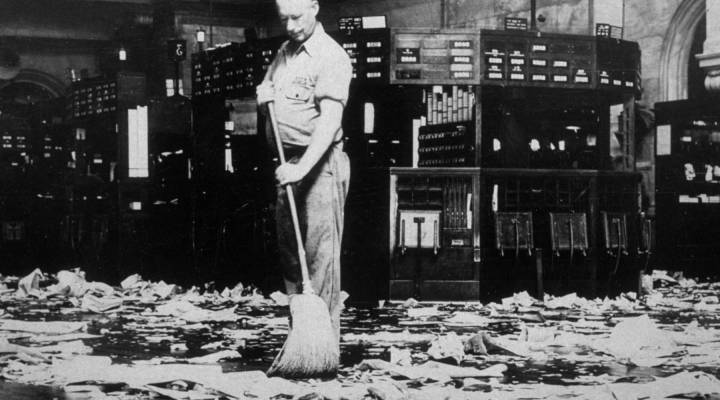
All buy myself … the thinking behind stock buybacks
All buy myself … the thinking behind stock buybacks

Back in 2007, CEO William McComb’s company suddenly found itself with more than $100 million in cash. The company — known at the time as Liz Claiborne Inc., now called Kate Spade — was selling off unwanted subsidiaries “and we had an inflow of cash,” as McComb put it.
It’s not a rare situation for a company to be in.
The question is what to do with the money?
“We had a number of options,” he said. At many companies, an option is to buy up more brands, but Liz Claiborne was in the process of getting leaner. Some companies will put cash into research and development, but “we’re an apparel company. We don’t have research and development,” McComb said.
The company could have done nothing and just sat on the cash.
In the end, said McComb, “the decision we made as a board was to return some cash to shareholders via a share buyback.”
Translation: The company bought … itself. It bought its own stock and took the shares off the market.
Share buybacks, or share repurchases as they’re also known, are an increasingly common strategy. From 2010 to 2015, the S&P 500 spent roughly $3.5 trillion on share repurchases.
Why do this?

Data compiled by FactSet show the number and quantity of share repurchases has increased sharply since the recession.
It’s a way, ostensibly, to increase shareholder value.
“With less shares, the idea is that the price [of the stock] will go up,” said Steven Davidoff Solomon, professor at U.C. Berkeley School of Law. It’s a way to tweak supply and demand of shares. “It’s a financial trick.”
Buybacks can also increase the inherent value of a share since each share now represents a larger piece of the company.
There is, of course, an obvious alternative way of increasing shareholder value, and that is for the company to simply cut each shareholder a check. This is known as a dividend.
The downside to a dividend, said McComb, is that “a dividend imposes a tax burden on shareholders immediately, so many shareholders would rather see a buyback versus a dividend.”
Stock buybacks also offer the advantage of improving the metrics by which many investors judge companies: earnings-per-share increase if the number of shares decreases.
Additionally, many executives are paid in stock options. So a dividend check doesn’t do much for them, whereas driving up the cost of shares certainly does.
“It’s masking a lot of hidden compensation,” according to Solomon.

According to data from FactSet, shareholder activism in pursuit of stock buybacks has increased since shortly after the end of the recession, and they’re becoming more successful.
Finally, the way the math can theoretically work out, shareholders don’t make as much money from a dividend check as they would by selling shares juiced up by a buyback.
But stock buybacks have some very strident critics.
Among them is William Lazonick, professor of economics at University of Massachusetts Lowell.
“You get dividends for holding the stock,” Lazonick said. “The only way you get money from stock buybacks is selling the stock. “
You have to sell the shares to make the money, which means someone benefiting from a share buyback is not necessarily invested in the company’s long haul, said Lazonick.
“Shareholder activists love stock buybacks because it’s a great way of taking money out of companies,” he said, adding that companies with a lot of cash become targets for investors who want to buy in, push for a buyback and sell out — basically, “milking out” money that could be used for other things.
McComb, the former CEO, concedes that buybacks can sometimes benefit short-term investors.
“More times than not in the last 10 years, it’s been in response to short-term activists that have been jumping in wanting to create and stimulate value and then get out.”
But McComb said his buyback was following the philosophy — a widely held one — that if your company has extra cash, you should give it to shareholders and do it in the most effective way you can. It’s a fundamental difference in world view compared with people like Lazonick.
“It really is an idiotic ideology, that you run the company for the people who matter least,” Lazonick said, referring to shareholders. “The people who can get in and out of the company quickest and for whom that is often their only goal.”
Lazonick would prefer dividends or sharing profits with employees. “Higher wages, more stable employment, better benefits — that’s where middle class comes from. That is in general what could be done with all that money,” he said.
McComb, the CEO, insists it’s not inherently bad to give money to shareholders through a buyback, but he does object to shareholder activism extracting value from a company at the expense of long-term interests. As for his own $100 million buyback back in 2007? He regrets it in a way.
“The world changed dramatically in late 2008, as we now know. And sure, it would’ve been much better for us and frankly our shareholders had we not returned the money via a share repurchase,” he said.
Spending cash on buybacks typically happens when the market is high and companies are flush with money. And, like for anyone with extra cash, you never know when you’re going to need it.
“The Price of Profits,” our series with Business Insider, looks at what happens when profits become a company’s product. For more, visit priceofprofits.org.
There’s a lot happening in the world. Through it all, Marketplace is here for you.
You rely on Marketplace to break down the world’s events and tell you how it affects you in a fact-based, approachable way. We rely on your financial support to keep making that possible.
Your donation today powers the independent journalism that you rely on. For just $5/month, you can help sustain Marketplace so we can keep reporting on the things that matter to you.



















